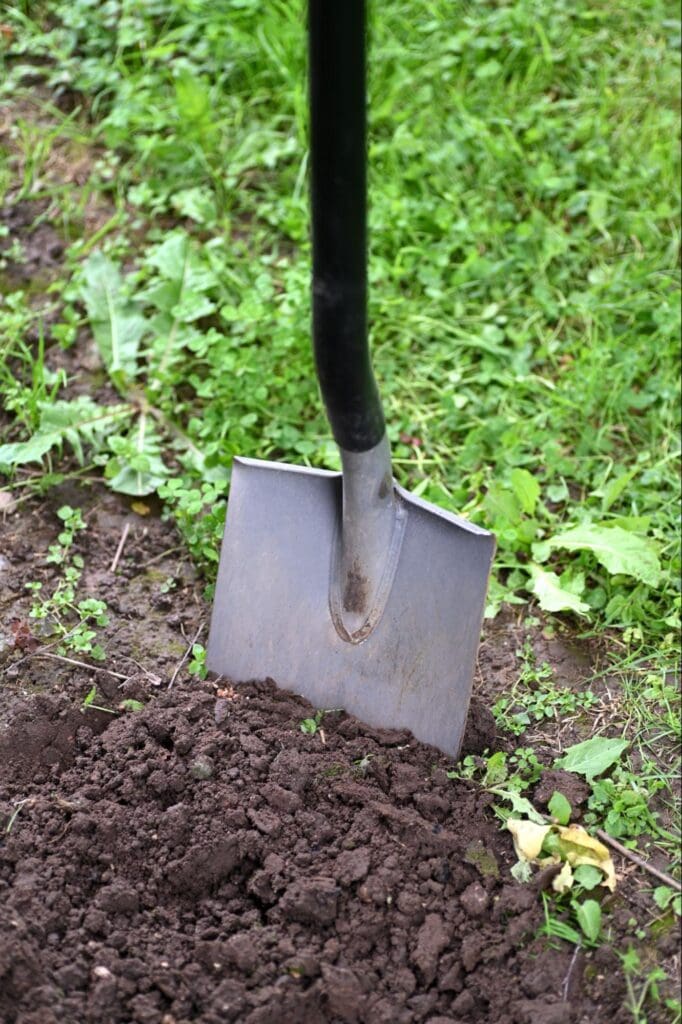The Digging Dilemma: How Deep to Dig for Pavers?
You’ve probably seen a paver patio before; you’ve likely admired one, eaten dinner on one, and even grilled on a paver patio, but have you ever stopped to consider how it was built? More specifically, have you ever wondered how deep to dig for patio pavers?

Building a paver patio is not rocket science, but there are specific steps you need to follow and certain tasks that need to be achieved, the first of which is excavating your proposed patio area.
To properly install a paver patio, you must first excavate the area so that you can build the appropriate base layers. The base layers provide proper drainage and help prevent substantial movement and heaving in the patio, to help ensure that you get a high-quality finished product that lasts a lifetime.
So how do you know how deep to dig for pavers? Several factors need to be considered to answer this question adequately.
What are Pavers?
The term “paver” typically refers to a man-made masonry product, usually manufactured from concrete. Pavers come in specific and consistent geometric shapes, most often squares and rectangles.
Pavers come in various colors, shapes, and sizes, in order to provide a wide range of products to match or complement any home, landscape, or design choice.
How Deep to Dig for Pavers?
To determine how deep you need to dig for pavers, you need to determine the following factors;
- What is the thickness of your paver?
- What is the required thickness of your bedding material?
- What is the required depth of your base material?
1. Thickness of Your Paver
Measure the thickness of the paver and record your measurement.
2. What is the Required Thickness of Your Bedding Material?
The bedding material is the thin sand or stone dust layer used to level the pavers on top of the base material. This layer is typically screeded to a height of about one inch.
3. What is the Required Depth of Your Base Material?
The base material typically consists of gravel or crushed stone and must be thoroughly compacted to ensure a high-quality installation. If your project requires a 6” base of gravel, that means 6” after full compaction.
Although codes and regulations vary across locations, a good rule of thumb is that you need between 4-6 inches of base material for patios and walkways and between 6-12 inches of base material for a driveway.
So how deep do you need to dig for pavers? Just add up your measurements.
(Thickness of your paver) + (Thickness of bedding material) + (Depth of base material) = How deep to dig for pavers.
Using TRUEGRID Permeable Pavers
A great alternative to traditional pavers are TRUEGRID permeable pavers.

Unlike standard concrete pavers that are impervious to water and can be susceptible to heaving, cracking, and movement, TRUEGRID permeable pavers are 100% pervious, will never crack, and are virtually maintenance-free.
Benefits of Using TRUEGRID Permeable Pavers:
Stormwater Management
TRUEGRID permeable pavers allow water to pass through them and back into the groundwater supply, so they can help reduce flash flooding and alleviate pressure on overworked storm drain systems.
Low Maintenance
TRUEGRID permeable pavers are immune to cracking, heaving, lifting, and splitting. By filling permeable pavers with gravel or grass, you will never need to worry about replacing broken or damaged pavers or resetting pavers that have come out of place. TRUEGRID permeable pavers are virtually maintenance-free.
Environmentally-Friendly
Made from 100% post-consumer recycled plastic (HDPE), TRUEGRID permeable pavers have kept millions of pounds of plastics out of waterways and landfills.
By creating a grass patio, walkway, or driveway reinforced with permeable pavers, you can also help to alleviate the heat island effect in your local area.
Additionally, by allowing stormwater to be returned to the ground, you are helping to replenish vital groundwater supplies.
Easy to Install
TRUEGRID permeable pavers are considerably easier to install than their rigid, concrete counterparts.
With TRUEGRID you have to dig even less than for concrete pavers.
TRUEGRID permeable pavers do not require a bedding material, so to find out how deep to dig for pavers, just measure the thickness of the permeable paver and add it to your required base material depth. Add an extra quarter-inch to half- inch so that the top of your permeable paver sits below grade.
Want an even more straightforward installation process? Check out the TRUEGRID ROOT® system to create structurally reinforced grass living spaces with no excavation whatsoever!
Choose TRUEGRID for an Eco-Friendly Alternative to Concrete Pavers
Since 2013, TRUEGRID has been developing environmentally-friendly and structurally superior paving alternatives that will help the planet.
Providing the PRO PLUS with industry-leading compressive strength for industrial applications, the versatile PRO LITE for patios and walkways, and the ROOT® for effortlessly reinforced grass landscapes, TRUEGRID has what you need for your next project.
View the entire lineup of TRUEGRID products, or get an online estimate today and discover how you can be true to your project and true to the environment with TRUEGRID.
Have you ever wished that you could have the functionality of a stone or concrete patio and incorporate the seamless, natural beauty of grass? If so, a grass patio is precisely what you’ve been searching for.

What exactly is a grass patio, and what are the benefits of having one? What are the different ways a grass patio can be constructed?
This article will answer all of these questions about grass patios and will give you the information you need to decide whether or not a grass patio is right for you.
What is a Grass Patio?
A grass patio is exactly what it sounds like; a patio made out of grass. The concept is simple, but the design can be a bit more complicated.
You might expect a grass patio to simply be an area of your backyard where you put a couple of tables and chairs, but this is not so.
An unsupported lawn may work great in the dry summer months, but an unimproved grass patio inevitably becomes a sloppy mess during the wet, rainy, spring and fall.
How can you remedy this situation?
Reinforcing your grass patio with concrete or permeable pavers provides a durable grass living space that drains water and maintains its integrity regardless of the weather. For this reason, most true grass patios are reinforced with one of these two methods.
Benefits of a Grass Patio
Building a grass patio has various benefits, including aesthetics, stormwater management, and environmental impact.
Aesthetics
The visual appeal of having a naturally flowing grass living space cannot be denied.
Concrete and paver patios create an exciting contrast to the natural world, and building a space that not only incorporates nature, but seamlessly continues it, is attractive on many levels.
Stormwater Management
When it rains, concrete, stone, and paver patios all shed water toward the street or other drainage systems that are in place, and while this is common practice, it is not effective stormwater management.
Most cities, driveways, streets, and roads are paved with asphalt or made of concrete, and storm drains are severely overworked by the incredible amounts of water they are expected to handle. Additionally, as this stormwater runs down roads, streets, and ditches, it picks up trash, oil, and other contaminants, which increases the stress on our water systems.
A grass patio allows stormwater to naturally be absorbed into the ground, to help alleviate the pressure on overworked drainage systems.
Environmental Impact
Not only does a grass patio benefit the environment by allowing precipitation to re-enter vital groundwater supplies, but it can also aid in minimizing “heat island effect.”
Heat island effect occurs when a large portion of a local area is made of concrete, asphalt, and other construction materials that store and radiate heat. If enough of an area is built from these materials, it can increase the average temperature by a noticeable amount.
By building more spaces out of natural materials like grass, you can reduce the heat island effect in your local area.
TRUEGRID permeable pavers are made from 100% post-consumer recycled HDPE, which makes permeable pavers a truly eco-friendly building material.
How to Make a Grass Patio
The two main ways to build a grass patio are by intermittently spacing concrete pavers and grass or by reinforcing your area with permeable pavers.
Pavers and Grass
Intermittently spacing pavers throughout a grass area in various geometric patterns is a popular method of creating a grass patio. However, while this method can be visually attractive, it does not truly make a grass patio; the pavers are typically the star of the show, while the grass is merely a role player.
Unfortunately, pavers simply placed in the soil can often be subject to heaving and moving, which can create irregular walking surfaces and dangerous tripping hazards.
Pavers spaced throughout a grassy area will not mitigate mud, and slop, and will leave you with many of the same problems you would have had with an unimproved section of grass.
TRUEGRID Permeable Pavers

Using TRUEGRID permeable pavers, you can create a beautiful and genuinely durable grass patio.
TRUEGRID PRO LITE pavers lock in the topsoil and prevent grass areas from becoming a muddy mess during wet, rainy seasons.
The permeable pavers also protect the grass’s delicate roots from being trampled and killed in high-traffic areas.
TRUEGRID permeable pavers are easy to install and can be quickly and efficiently assembled by any motivated DIYer. However, if you want to create a beautiful, reinforced grass living area without the hassle of excavation, TRUEGRID’s ROOT® system has you covered for the fastest and easiest way to create a grass patio.
Create Beautiful and Practical Grass Surfaces with TRUEGRID
Since 2013, TRUEGRID has been designing and manufacturing eco-friendly paving alternatives for a more innovative, healthier world.
Create industrial-strength grass paving areas with the TRUEGRID PRO PLUS and experience industry-leading compressive strength, or create beautiful residential grass patios and walkways with the PRO LITE. Whatever your needs, TRUEGRID has what you need to get your job done right!
View the full lineup of TRUEGRID products, or get a quote online today and discover how you can be true to your project and true to the environment with TRUEGRID!
California stormwater regulations are a crucial aspect of environmental protection in the Golden State, which is prone to heavy rainfall and has undergone substantial urban development.
In California, strict stormwater regulations are in place to ensure the preservation of water quality and prevent flooding.

Understanding and meeting California stormwater regulations is essential for individuals, businesses, and municipalities alike. In this article, we will provide a simple breakdown of California stormwater regulations and offer practical tips on how to meet them.
California Stormwater Regulations: An Overview
California stormwater regulations are a set of rules and requirements implemented by the State Water Resources Control Board (SWRCB) to manage and control the impact of stormwater runoff on water quality and prevent flooding.
These regulations are enforced through the National Pollutant Discharge Elimination System (NPDES) program.
Critical aspects of California stormwater regulations include:
- Obtaining coverage under the appropriate general permit
- Developing and implementing Stormwater Pollution Prevention Plans (SWPPPs)
- Following Best Management Practices (BMPs) specific to different sectors and activities
These regulations aim to minimize pollution from various sources, such as construction sites, industrial activities, agriculture, and storm sewer systems.
Compliance with these regulations is essential for individuals, businesses, and municipalities to ensure the preservation of water quality and environmental protection.
General Permit Requirements
The first step to compliance is obtaining coverage under the appropriate general permit. California has several general permits for different sectors, such as construction, industrial activities, and municipal storm sewer systems.
Each permit outlines specific requirements and best management practices (BMPs) that must be followed.
Stormwater Pollution Prevention Plans
A stormwater pollution prevention plan is a comprehensive document that outlines measures to prevent pollution and control runoff. It includes information on construction site characteristics, potential pollutant sources, and strategies for erosion and sediment control, among other things.
Developing and implementing a stormwater pollution prevention plan is crucial for most regulated entities.
Best Management Practices
Best management practices are techniques or measures designed to control and reduce stormwater pollution.
Best management practices vary depending on the sector and activity, but commonly include sediment and erosion control, spill prevention and response, runoff treatment, and pollution source control.
Identifying and implementing the best management practices for your specific situation is vital to meeting the regulations.
Tips for Meeting California Stormwater Regulations
Education and Training
Stay informed about California stormwater regulations and seek training opportunities to enhance your knowledge. This will help you understand your responsibilities and keep up with any updates or changes in the regulations.
Obtain All Required Permits
Obtain all permits required to satisfy California stormwater regulations. This effort will keep you out of legal trouble and ensure that you have taken the appropriate steps with the California government to proceed with your project.
Stormwater Pollution Prevention Plan
If you fall under the requirements for a stormwater pollution prevention plan, invest the time and effort into developing a comprehensive plan.
Consider hiring an experienced professional to assist you in the process. Once the SWPPP is in place, ensure its effective implementation by regularly inspecting and maintaining erosion control measures, practicing good housekeeping, and promptly addressing any issues or deficiencies.
Site Design and Construction
Plan and design your site with stormwater management in mind if you are involved in construction activities.
Implement erosion control measures, such as sediment barriers, silt fences, and gravel construction entrances. Minimize disturbed areas and maintain vegetative cover as much as possible. Properly manage stockpiles and store construction materials in designated areas to prevent runoff contamination.
Pollution Prevention
Implement proactive measures to prevent pollution from occurring. Train employees on spill prevention and response procedures; store chemicals and hazardous materials in appropriate containers and areas; and regularly inspect and maintain equipment to prevent leaks and spills.
Implement good housekeeping practices, such as keeping storage areas clean and organized, to minimize the risk of pollutants being washed away by stormwater.
Monitoring and Reporting
Regularly monitor stormwater discharges, collect required samples, and keep accurate records of your activities. Familiarize yourself with the reporting requirements outlined in the general permit and submit the necessary reports on time.
Create Eco-Friendly Stormwater Management Solutions with TRUEGRID
Since 2013, TRUEGRID has been developing environmentally friendly paving alternatives for Californians, and the rest of the world, to build more sustainable outdoor living spaces with superior stormwater management.

TRUEGRID permeable pavers are made from 100% post-consumer recycled HDPE and have helped prevent millions of pounds of plastics from polluting our waterways and entering our landfills.
Need to build a commercial parking lot or roadway? TRUEGRID’s PRO PLUS permeable paver has unparalleled compressive strength to easily handle vehicle traffic, heavy machinery, and semi-trucks.
Want to create a beautiful, naturally draining walkway or patio? TRUEGRID’s easy-to-install PRO LITE pavers are just what you need to create the landscape of your dreams.
Interested in creating a durable, reinforced grass patio or walkway but don’t want to deal with the hassle of excavation? Check out TRUEGRID’s innovative new ROOT® system to create eco-friendly landscapes more easily than ever before.
Need help meeting California stormwater requirements? View the entire lineup of TRUEGRID products, or get an online quote today and discover how you can be true to your project and true to the environment with TRUEGRID!

